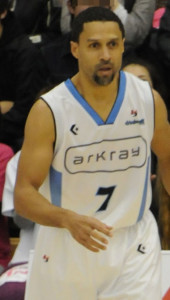At 50 years old, he’s one of the biggest stars in the BIG3 basketball league. When he played in the NBA, he shot 1,161 free-throws with a shooting percentage of 90.5.
In 1990, he was the third pick in the NBA draft, where he dominated the basketball court in his time as a player for the Denver Nuggets.
Mahmoud Abdul-Rauf (born Chris Jackson) has long been hailed as one of the top shooting guards in the 1990’s.
He also has Tourette’s Syndrome.
Want to learn more about Abdul-Rauf’s inspiring journey?
Read on to understand how he never let his Tourette’s stand in the way of his dreams — and how you can follow his incredible example.
The Early Years
Mahmoud Abdul-Rauf was born in 1969 in Mississippi, one of three sons that his mother Jacqueline gave birth to.
A single mother, Jacqueline worked in a cafeteria to make ends meet. She also displayed signs of Tourette’s Syndrome.
Abdul-Rauf’s early years were characterized by poverty, and he and his brothers often went hungry and even missed school. He was placed in special education classes early on, though his Tourette’s was not formally diagnosed until he turned 17.
He found solace on the neighborhood basketball court. Even though he says he didn’t know the real rules of the game, the first time he played for his middle school team, he scored 24 points.
Soon, he was the top player at his high school. His talent certainly didn’t go unnoticed, and he won the title of Mississippi Mr. Basketball two times. He continued to play as a college student at LSU, and ended up setting the scoring record for a freshman.
He also played with Shaquille O’Neal at LSU, who was then already known as an incredible defensive player.
He went on to be named the SEC Player of the Year and as a First-Team All-American for two years in a row.
He joined the NBA in 1990.
An NBA Player with Tourettes
In watching Mahmoud Abdul-Rauf highlights, you might not notice that he has Tourette’s at first.
Though he does have a milder case, if you pay attention — and read up on interviews he’s given — you get a deeper understanding of how Tourette’s impacts the way he plays the game.
Sometimes, Tourette’s convinces people that they must achieve difficult goals and do things “perfectly” before they can move on. This is how Abdul-Rauf learned to shoot the perfect free throws that made him so famous.
He wouldn’t rest until the ball had hit the next perfectly, until the ball was positioned in his hand just right, and until he got the kind of spin he was looking for. He would shoot hundreds of free throws every day.
His Tourette’s also sometimes makes it difficult for him to tie his shoes and get dressed for a game. It’s the reason behind his signature “Whoop” on the court. He also sometimes blinks and jerks his head, neck, and shoulders.
However, he says that he finds relief from his Tourette’s on the court — and the below YouTube reel is a great example of the kinds of skills that he has.
He’s also responsible for raising awareness about Tourette’s Syndrome and making it a part of the public conversation. He saw his fame as a chance to educate others about Tourette’s (like in this PSA from 1990) and encouraged those with Tourette’s to ask for help.
Mahmoud Abdul-Rauf’s Time in the NBA
With so much buzz surrounding this young and promising new player, Abdul-Rauf struggled to meet expectations in his first years as an NBA player.
He sustained a serious injury to his foot, didn’t play much, and at times scored as few as ten points per game. The public faith in him was starting to slip.
He decided to undergo a personal change, converted to Islam in 1993, and officially changed his name to Mahmoud Abdul-Rauf. That same year, he finally started to play the kind of basketball he knew he really could. He scored close to 20 points per game and ended up winning the NBA’s Most Improved Player award.
He was especially loved by fans for his jump-shots, his fakes and crossovers (which he often joked that his Tourette’s helped out with) and his unbeatable speed.
In 1994 and 1995, he played a leading role in helping the Denver Nuggets made it to the playoffs in one of the most stunning upsets of all time.
After the NBA
 Abdul-Rauf has played basketball all over the world, including Turkey, Saudi Arabia, Russia, Canada, and even Japan.
Abdul-Rauf has played basketball all over the world, including Turkey, Saudi Arabia, Russia, Canada, and even Japan.
He has also dedicated much of his time to connecting with children in inner cities, raising awareness about Tourette’s, and fighting for religious equality.
He is even considered a political activist today, standing behind Colin Kaepernick and other players with outspoken political and personal views.
He has five children and plays in Ice Cube’s BIG3 league, capturing the hearts of sports fans everywhere.
Mahmoud Abdul-Rauf Never Let Tourette’s Stop Him
Though Mahmoud Abdul-Rauf faced ridicule from teammates, other players, and fans for his Tourette’s, he never let it get in the way of his dreams.
He also stood up for his religious beliefs, even if it meant he had to pay serious fines and even sit out games.
If you or someone you love has Tourette’s Syndrome, show them this article to remind them that anything is possible — and that sometimes, your Tourette’s can even pave the way for your success.
Want to connect with other people who have Tourette’s syndrome? Looking to make new friends or find a relationship with someone who supports and understands you? Interested in even more inspiring stories?
Become a member of our community to dip your toe into the dating pool, get dating and relationship advice, and to understand the power of being different.



